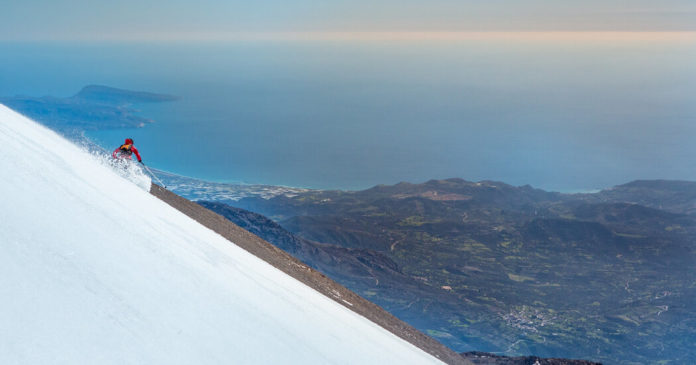“Here, now,” our local guide, Nikos Kalatzakis, said on cue, “we have found the Holy Spirit.”
It looked heavenly, but we hadn’t yet fully tested the snow, at least not for skiing down. The springlike conditions had felt promising on the way up, but it was mid-afternoon by now and the sun had been on the snow for hours. Surely, I thought, it would be un-skiable mush.
Then came a Cretan revelation: The snow was perfect “corn,” and it would pretty much remain that way every day, all day, for the entirety of our stay.
A skier’s delight, “corn snow” is usually a fleeting phenomenon, happening for a few hours on warm spring days when the sun melts the top few inches on frozen slopes, creating a thin blanket of kernel-size crystals. Almost always, after a certain time of day, the snow melts to a point that it collapses under a skier’s weight, and the fun is over. Not so on Crete. As Mr. Papanicolaou explained from his years of skiing and filming here, “due to the mountains’ proximity to the sea, new snowfalls are so moist that they quickly consolidate into one dense layer that often holds up all day in the spring.”
After several hours of climbing and two spectacular descents, we settled into the Chania Mountaineering Club’s Katsiveli Refuge. The rustic stone structure at the base of Crete’s second highest summit (by only a few yards), Pachnes, came equipped with blankets and mattresses, and a small heating and cooking system.
A basic dinner of rice and lentils seemed hardly enough, but we all collapsed after a cup of the slightly spicy Cretan tea, malotira, made from a flowering plant that grows at Crete’s higher elevations. Cretans have been consuming it since antiquity for its reputed medicinal qualities as an antioxidant and immune booster. We slept deeply.
The following day we skinned to the summit of Pachnes for a long descent, the last section of which was a cruise through a stunted forest of cedar, juniper and oak. We emerged on a plateau above the little fishing village of Sfakia, on Crete’s southern coast, gliding on a road until we ran out of snow. There, we were met by a taxi, arranged the day before.
It was early evening and the route home wound through the tiny village of Anopolis where villagers sat outside in the last of the sunlight fading over the Libyan Sea. Many were dressed in black, the men bearing beards — a common sight in the mountains, mourning traditions that many observe for much of their lives to honor deceased family and ancestors and the deaths from Crete’s defiant struggle against invaders.
Credit: Source link

















